recursion


I received the giraffe image in this youtube as it was being sent around by many people, and I can’t find the original. I have traced it to possibly generated by the pseudonym “ohyeahgirl”. Info welcome!
iteration
I learned the concept of iteration through computer simulation modelling. In developing a simulation, a variable of interest is submitted to a process repetitively, but always with the process acting on the most recent change.
As mentioned in the youtube, compound interest is the simplest form of an iterative change. There is a clear distinction between the result and the process. This is fundamental to all circular operations. When something is repeated cyclically, and coupled with a linear process (such as time, or displacement) a new phenomenon arises. The new phenomenon may be constant (simplest example is walking) or it may be cumulative as in compound interest of population growth.
self similarity
Self similarity is based on an iterative process. The simplest form is to take an image, make a copy of it, make it smaller, and attach the smaller copy to a predetermined place (or places) on the original. The process is repeated again and again, in what would be an infinite progression if one were to continue it.
The repeating process can be written into a rule or equation, or it can be assembled, as for example whittling and painting a set of nested dolls. Since many plants generate the repeating process internally (e.g. the fronds of a fern) we can discriminate between external and internal, or generative forms of self similarity. The result can be as graphic representation, or a tangible object. In either case the result of the process again happens in a different domain than the process.
self recursion
Self recursion is a recursion defined in terms of itself, resulting in what can be seen as an “ill defined regress” or an “opportunity for new domains” ... according to the situation. Self recursion is almost entirely limited to math, computer science, and natural language. All of these forms of self recursion are created by people; they can all be considered forms of language. The one exception I am aware of is molecular autopoiesis, as discussed elsewhere on this website.
In mathematics and computer science the open-endedness of an infinite regress is a problem. Conceptually, people can rarely conceive of more than one or two layers of self recursion in language (e.g. “understanding understanding” is but one layer or step, and it takes thought to “get it”. ) However - in natural language a self recursion can result in a new domain that is relevant to how we live in the worlds we conceive. A new domain can generate new possibilities that simply cannot be predicted ahead. It is “emergent” or “arises” from the operation.
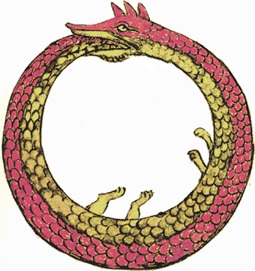
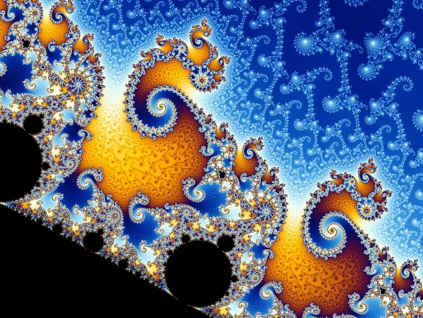
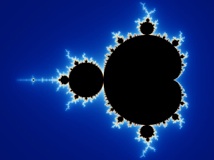
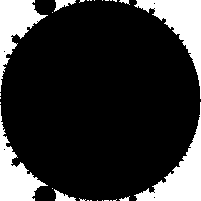
interwoven distinctions
Distinctions are always based on some regularity, or pattern, that we sense in one way or another. Complex systems can have many different kinds of regularities, so we can (and do) pay attention to different aspects of these regularities as we try to explain what they are and what they do. These differences are manifest in the various logos used by the American Society for Cybernetics (ASC) over the years.
For here I would like to present some distinctions that are implicit in various understandings of recursion. Some are interwoven, that is, more than one notion may apply to a given variant of how people think of recursion. The notions you will find discussed below are iteration, self similarity, self reference, and self recursion. I would like to point out that a) this is my understanding, and;
b) it is only relevant to you if you are interested in thinking about this.
recurrent or recursive
The root of the word is from the Latin recurrere, (run back). My image is of an early courier (same root), the runner, going back to fetch something. The word recurrent, something happening again, has the same root but we usually make a distinction in their use; recurrent emphasizes the “happening again” aspect, while recursive emphasizes the “coming back” aspect. We speak of seasons as recurring in a predictable cycle, we don’t think of them as recursive. According to dictionary.com. the word recursive is used for a rule or a procedure that is applied repeatedly.
In systems studies the word takes on various even more subtle nuances.
In general, recursion is taken to mean a circular reference, also known as a self reference. The image of the ourorobos, the snake biting its own tail is often used to denote this.
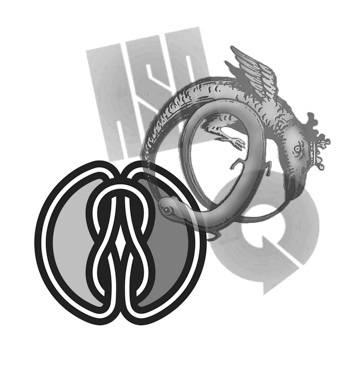
domains
What is a domain? Simply put, it is the home or domus of an idea. You can think of that as the field or context in which that idea belongs or makes sense. (There is more on domains in the section on distinctions, but I suggest this will be more meaningful after exploring the origin and evolution of language)
The logo I designed for the American Society for Cybernetics during my tenure as president is intended to show a circularity between two domains: the domain of our biologically based living in a tangible world (as represented by the California slender salamander) and the domain of ideas (as represented by the mythical ourorobos). Each influences what happens in the other - that is the domains interact as we live them.
Fractals and their cousins (e.g. Madelbrot sets, as pictured here) are based on iterative self-similarity. They are not perfectly self similar, or they would not produce the beautiful images that are based on a colour code for numeric values. However, some parts of the pattern do remain constant as they “grow” through ever more microscopic repetitions that we can zoom in on mathematically.

If you are interested, and are comfortable with technical language, the article on Mandelbrot sets (source of my images here) is worth a look.
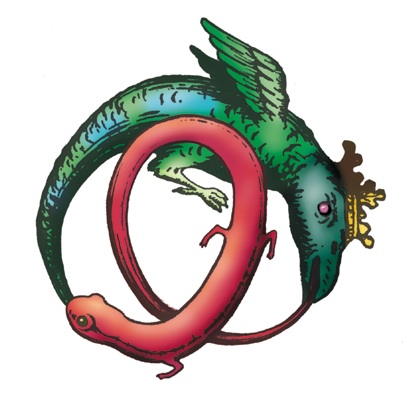
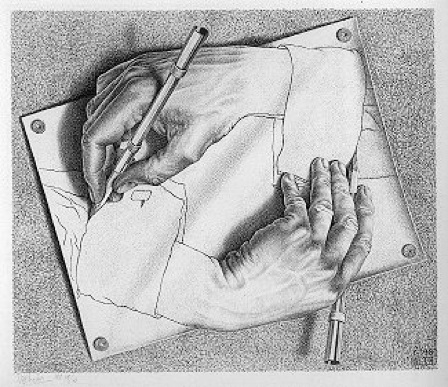
The problem with self reference is logic. Self reference is not logical. First it is based on a circular argument. Logic doesn’t permit circular arguments. Second, it switches from one domain to another, often right in the middle of a statement or idea. The two domains are not commensurate, they cannot be resolved logically. Logic is only powerful as long as it is applied to a specified domain; indeed part of the discipline of logic is to avoid confounding domains. If we want to use logic in situations that are inherently multidimensional (consist of multiple domains of distinctions) we need to reduce the complexity to a single domain, such as for example mathematics.
Most examples of self reference are verbal. Self reference isn’t found, it is created by people in language. It requires language, either natural or symbolic, to be conceive and to be expressed. Language has the property of generating domains along with distinctions, and it is sometimes possible to pack two domains into one statement - so that a paradox arises.
Escher, 1948. Drawing Hands (Wikimedia commons)
Dilbert, Sept. 27, 2009 (selection)

self reference
Self reference may sound a bit like self similarity, but it isn’t the same at all. Self reference is when an idea refers to itself in its own constitution. Its a kind of catch-22 logic that circles back on itself.
Paradoxes, as far as I can tell, always entail to different domains, or two different ways of thinking about something in a way that does not make sense in either domain alone. Thus it appears that paradox can only be resolved by creating a new domain that “makes sense” -- and reveals how the two original domains are at odds.


Recursions, of any type or definition are processes. As these processes operate, or are operated,
a new phenomenon or domain arises.


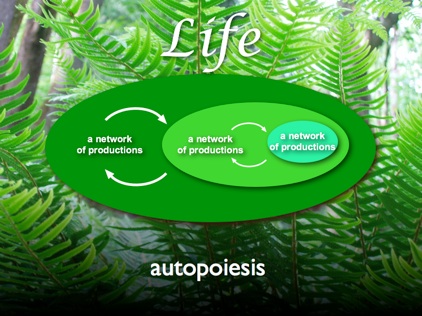
dragon and lizard
dancing the circular path
of myth and nature
haiku, Kathleen Forsythe



